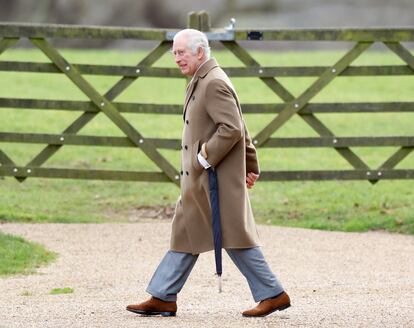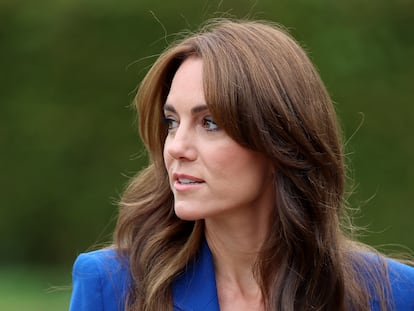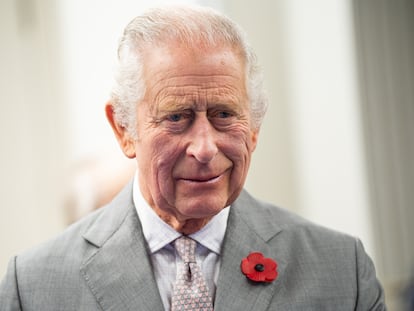King Charles III is admitted to a hospital for a scheduled prostate treatment
Charles, who ascended the throne 16 months ago, was diagnosed with the benign condition on Jan. 17 after he experienced undisclosed symptoms

King Charles III was admitted to a private hospital on Friday to undergo a “corrective procedure” for an enlarged prostate, Buckingham Palace said, confirming a pre-planned treatment that was announced last week.
The 75-year-old monarch will be treated at the London Clinic, where the Princess of Wales, his daughter-in-law, is recovering from abdominal surgery. The king visited Kate at the hospital after he arrived.
“The King was this morning admitted to a London hospital for scheduled treatment,’’ the palace said. “His Majesty would like to thank all those who have sent their good wishes over the past week.″
Charles, who ascended the throne 16 months ago, was diagnosed with the benign condition on Jan. 17 after he experienced undisclosed symptoms. He canceled engagements and was urged to rest ahead of the procedure.
The king decided to announce the surgery in advance in an effort to encourage other men to have their prostates checked in line with public health advice.
The palace said the king was “delighted to learn that his diagnosis is having a positive impact on public health awareness.’’
The prostate is a small gland that surrounds the urethra — the tube that carries urine out of the body. An enlarged prostate can put pressure on the urethra and make it more difficult to urinate.
Britain’s National Health Service recommends that men see their doctors if they notice any problems with, or changes in, their usual pattern of urination. Surgery is usually only recommended when a patient experiences moderate to severe symptoms that don’t respond to medicine.
Benign prostate enlargement is common in men over 50, and normally it isn’t a serious health threat, the NHS says.
“The risk of prostate cancer is no greater for men with an enlarged prostate than it is for men without an enlarged prostate,” the agency says on its website.
News of the king’s treatment came amid a flurry of royal medical news over the past 10 days.
The Princess of Wales’ office at Kensington Palace said on Jan. 16 that the princess had undergone planned abdominal surgery for an undisclosed condition. The palace didn’t provide further details but said her condition wasn’t cancerous.
The 42-year-old princess, formerly Kate Middleton, is the wife of Prince William, the heir to the throne. She is on day 11 of her hospital stay and is expected to remain in the hospital for up to two weeks, the palace says.
Though she is physically active and has generally experienced good health, Kate was hospitalized with severe morning sickness when she was pregnant.
Soon after Kate was hospitalized last week, the Duchess of York was diagnosed with a malignant skin cancer that was discovered during treatment for breast cancer. The melanoma was found after several moles were removed while she was undergoing reconstructive surgery after a mastectomy.
The duchess, 64, the ex-wife of Prince Andrew and the mother of Princesses Beatrice and Eugenie, was once a favorite target of Britain’s tabloids. The former Sarah Ferguson, often called by her nickname, “Fergie,” has written a number of children’s books, as well as a historical romance for adults.
While it is somewhat unusual for members of the royal family to release details about their health, the announcements about Charles and Kate’s conditions were seen as a way to avoid speculation because appearances would have to be postponed or canceled.
Stories about the health of Britain’s senior royals have been in the news repeatedly in recent years.
Speculation about the health the late Queen Elizabeth II increased during the last months of her 70-year reign as undisclosed “mobility issues” limited her public appearances. After that, focus switched to Charles, who ascended the throne at an age when most of his contemporaries were long retired.
Sign up for our weekly newsletter to get more English-language news coverage from EL PAÍS USA Edition
Tu suscripción se está usando en otro dispositivo
¿Quieres añadir otro usuario a tu suscripción?
Si continúas leyendo en este dispositivo, no se podrá leer en el otro.
FlechaTu suscripción se está usando en otro dispositivo y solo puedes acceder a EL PAÍS desde un dispositivo a la vez.
Si quieres compartir tu cuenta, cambia tu suscripción a la modalidad Premium, así podrás añadir otro usuario. Cada uno accederá con su propia cuenta de email, lo que os permitirá personalizar vuestra experiencia en EL PAÍS.
¿Tienes una suscripción de empresa? Accede aquí para contratar más cuentas.
En el caso de no saber quién está usando tu cuenta, te recomendamos cambiar tu contraseña aquí.
Si decides continuar compartiendo tu cuenta, este mensaje se mostrará en tu dispositivo y en el de la otra persona que está usando tu cuenta de forma indefinida, afectando a tu experiencia de lectura. Puedes consultar aquí los términos y condiciones de la suscripción digital.
More information
Archived In
Últimas noticias
Most viewed
- Reinhard Genzel, Nobel laureate in physics: ‘One-minute videos will never give you the truth’
- Oona Chaplin: ‘I told James Cameron that I was living in a treehouse and starting a permaculture project with a friend’
- Pablo Escobar’s hippos: A serious environmental problem, 40 years on
- Why we lost the habit of sleeping in two segments and how that changed our sense of time
- Chevy Chase, the beloved comedian who was a monster off camera: ‘Not everyone hated him, just the people who’ve worked with him’










































